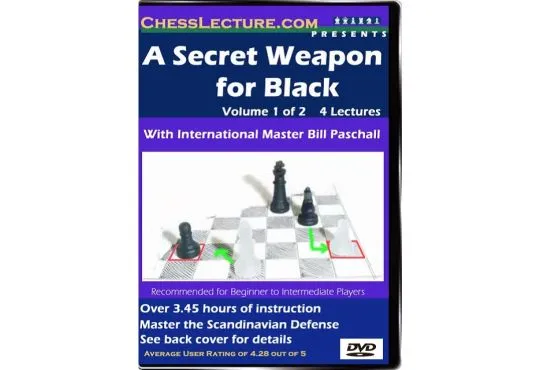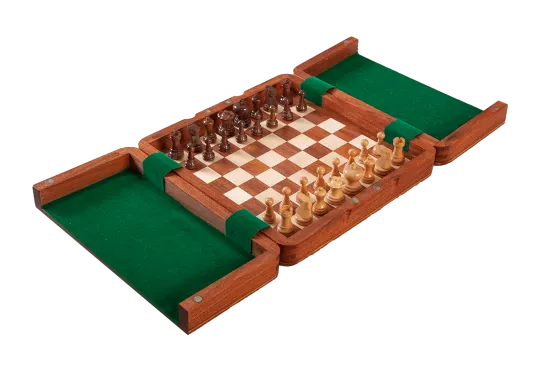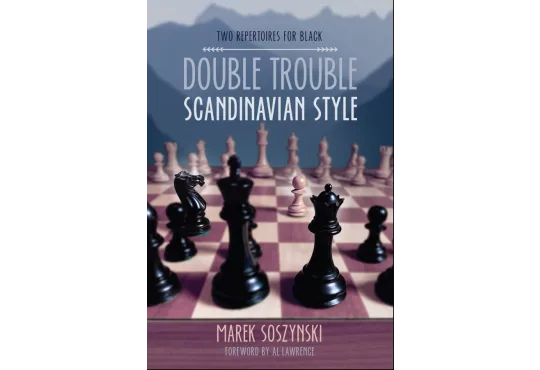Take the fight to White with the Scandinavian Defense
If you’re bored of White calling the shots after 1.e4, the Scandinavian Defense might be for you. By countering 1.e4 with 1...d4, Black refuses submission and takes the game into its own hands.
But isn’t 1...d5 reckless? A beginner’s move? Far from it. The Scandinavian Defense is gaining an ever-growing following, and statistics have backed up its efficacy. It wins more games than 1...e5, often leading to open games that prevent White from controlling the center.
Here’s our guide to a robust and rebellious opening for Black.

Table of contents
History
The Scandinavian Defense is one the oldest openings in chess. In fact, the opening features in the 1475 Valencian love poem ‘Scachs d’amor’ meaning the ‘Chess of Love’. Although the game was fictional, it remains the oldest-known annotated opening in history!
The Scandinavian Defense has fallen in and out of favor in the centuries since. Revisions in opening theory have seen the Scandinavian enjoying a renaissance in recent decades. The opening debuted in the World Championship in 1995.
Today, the opening makes frequent appearances in international tournaments and is even played from time to time by world number one, Magnus Carlsen. The 'Scandi' is even more popular among amateur players, especially since online records have revealed the opening as a particularly successful choice for Black at club level.
Pros and Cons of the Scandinavian Defense
Pros
Bypasses Endless Opening Theory
While the Scandinavian Defense is used to answer 1.e4 at every level of chess, it’s an especially smart choice for amateur players who would rather avoid studying the endless openings that follow 1...e5.
Instead 1...d5 puts Black in control. By learning some basic theory, you have an excellent chance of knowing the opening better than White - a great opportunity to win an equal or favorable position with Black.
Ideal for Blitz Games
Another perk of the Scandinavian is that it’s an aggressive opening that can quickly lead to attacking avenues for Black. In blitz chess where you don’t have the time to play the long game for position, you may prefer to play unusual, aggressive openings to surprise your opponent and win a quick advantage.
Statistically Strong at Amateur Level
According to chess database records at lichess.com, of more than 375 million online games that begin with 1.e4 d5, Black wins 47% of games. Compare that with only 45% when Black answers with 1...e5.
-
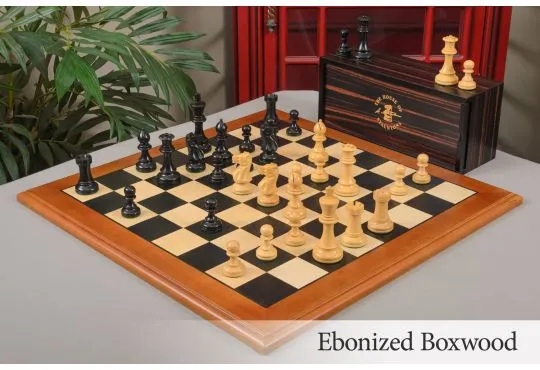 Free Worldwide Shipping
The Superior Grandmaster Chess Set, Box, & Board Combination Enjoy Savings of 24% Off MSRP When Purchased as a Combination
Free Worldwide Shipping
The Superior Grandmaster Chess Set, Box, & Board Combination Enjoy Savings of 24% Off MSRP When Purchased as a Combination$457.00
Starting at $349.00
To $428.95
-
 CLEARANCE - The Scandinavian for Club Players Start Playing an Unsidesteppable & Low Maintenance Response to 1.e4Special Price $10.00 Regular Price $24.95
CLEARANCE - The Scandinavian for Club Players Start Playing an Unsidesteppable & Low Maintenance Response to 1.e4Special Price $10.00 Regular Price $24.95 -
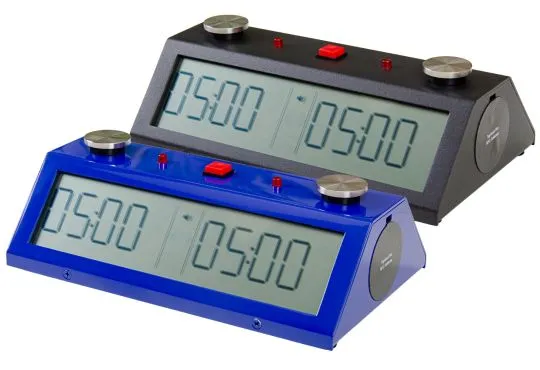 Tap N Set Pro Digital Chess Clock The Official Chess Clock of the US Chess Federation - The World's Only Smart Phone Programmable Clock
Tap N Set Pro Digital Chess Clock The Official Chess Clock of the US Chess Federation - The World's Only Smart Phone Programmable ClockStarting at $124.95
To $129.95
Cons
Forces the Queen Out Early On
The most glaring drawback of the Scandinavian Defense is that most lines demand the Queen to enter the center of the board in the first few moves. Breaking all the rules of traditional opening theory, developing the queen so early exposes her to easy attack from the opponent.
Luckily, there are ways to prevent this from costing too many tempos if Black knows what to do.
Less Strong at Master Level
The Scandinavian Defense is only played in 2% of games at master level, and despite winning more games than 1…e5, the low rate of draws means it earns Black fewer points overall than either 1...e5, or 1...c5.
Bear in mind, however, that master chess is another world compared to the amateur game! Besides, some specialists like Sergey Tiviakov have managed to score a majority with the Scandinavian at master level.
Traps for White
Another potential shortfall of the Scandi opening is that there are several traps that White can lure unsuspecting Black players into! All of these can be side-stepped, but Black must study the worst of them to avoid becoming ensnared.
See the subheading 'Attacking Options for White' below to review two of the worst!
Two Main Lines
The main lines of the Scandinavian Defense assume that White captures the pawn (2.exd5). Indeed, this is considered White’s strongest option, but be sure to read the subsections further down to ready yourself for other variations White might try!
Scandinavian Defense Mieses Kotrč Variation: 2...Qxe5
The most common line for Black to take after 2.exd5 is simply to recapture the pawn with the queen. Known as the ‘Mieses-Kotrč Variation’, this does expose Black’s queen in the center of the board, which goes against conventional opening theory.
Fortunately, there are lines that let Black handle the inevitable pressure that follows:
3.Nc3 Qa5
After 2...Qxe5, White’s natural and best move is 3.Nc3 to attack the queen. Black now has several places it could move the queen, but 3...Qa5 is best. Here, the queen remains in a commanding position, yet out of reach from immediate attacks.

From here, Black can shoot for a setup that works well almost regardless of White might play. By soon following with pawn to c6, Black creates an escape route for its queen while defending d5 and b5 from White pieces.
In the following moves, Black typically plays Nd7, Nf6, and e6. Bg4 is also played as soon as White has played Nf3. If White attempts to X-ray the Queen with Bd2, Black can simply retreat with Qc7 – a comfortable yet influential square.

Now Black can threaten White’s h2 pawn by playing Bd6 - an attack White might miss altogether in blitz games. Black's robust position is defensively sound, with plenty of attacking opportunities to follow.
Scandinavian Defense Modern Variation: 2...Nf6
There is an alternative for Black that offers to recapture White’s pawn without centralizing the Queen. In the Scandinavian Defense Modern Variation, Black instead plays 2...Nf6.

White’s Error: 3.Nc3 Nxd5 4.Nxd5
With the queen and the knight now threatening e5, there are few options for White to preserve the pawn. While the line 3.Nc3 Nxd5 4.Nxd5 seems natural enough for White, 4...Qxd5 allows Black to enjoy a centralized queen without being hassled by White’s queenside knight. Even chess engines agree that Black’s position is equal to White’s at this point.
Black can then go on to castle on the queenside and happily fire pawns at White’s kingside.
-
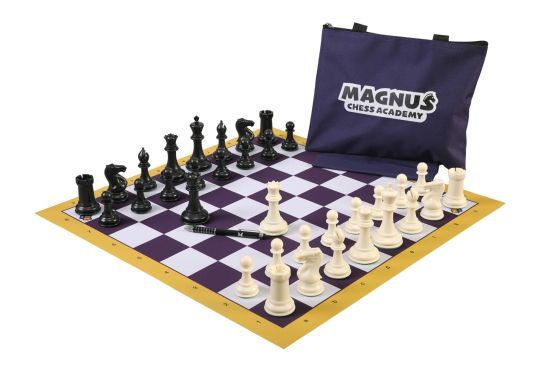 Magnus Chess Academy Signature Series Chess Set, Bag And Board Combination The OFFICIAL Magnus Chess Academy Branded Collection!$34.99
Magnus Chess Academy Signature Series Chess Set, Bag And Board Combination The OFFICIAL Magnus Chess Academy Branded Collection!$34.99
Rescue the Pawn! 3.c4
After 2...Nf6, White only has one move to preserve its pawn advantage: 3.c4. Black’s best option now is simply to offer White another pawn exchange. After 3...e6 4.dxe6 Bxe6, White is a pawn up, but without any pieces developed. Black, on the other hand, has two pieces in play with some dangerous options to follow. 5...Qe7, threatens a discovered check on the White king, while if White advances its queen's pawn, Bb4+ can also prove troublesome.

Other Options for White
In 64% of online games, White answers the Scandinavian with 2.exd5. But there are other options. Many of these are errors, so let’s look at how to capitalize on them before moving on to two of White’s more dangerous lines.
Punishing White’s Errors
2.e5?
Sometimes, White will attempt to avoid the pawn exchange altogether by pushing its pawn to e5, but this only makes it vulnerable to capture.
Black can cut off White’s queen pawn from coming to the rescue with 2...c5. Black's light-squared bishop can also take care of Nf3 by pinning it with Bg4.

2.Nc3?
2.Nc3 is exposed as an error when Black counters with 2...d5. White must now retreat the knight to avoid losing tempos. If White tries either 3.Nb5 or 3.Nd5, Black simply keeps kicking with its pawns, assuming central control all the while.

2.d3?
2.d3 is equally untenable. After both sides exchange pawns, the d-file is clear for Black to swap queens. White must recapture with the king, leaving it stuck in the middle of the board, unable to castle.
Attacking Options for White - Tricks and Traps Against the Scandinavian Defense
Sometimes White will simply refuse to be on the receiving end and transpose the Scandinavian into its own attacking openings:
2.e4 – The Blackmar Diemer Gambit
The second most common response to the Scandinavian Defense is 2.e4. Putting White back in the driving seat, this transposes into the Blackmar-Diemer Gambit – a fiery opening usually achieved with 1.d4 d5 2.e4.
White offers a sacrificial pawn in exchange for speedy development. The opening is considered dubious at master level, but can sometimes pay off in the amateur game, especially in blitz and bullet games.
The main line follows: 2...dxe4 3.Nc3 Nf6 4.f3 exf3 5.Nxf3. After this, Black has many options, meaning it’s worth studying at least one of them if you’re planning to play the Scandinavian as Black! There are also some sneaky traps to watch out for like the infamous ‘Halosar’ Trap’.
Equally, if you’re looking for an aggressive line to counter the Scandinavian Defense as White, the Blackmar Diemer may prove well worth learning!
2.Nf3 – The Tennison Gambit Wins a Queen!
A wild and risky line White can deploy to lure Black into a fatal trap is the Tennison Gambit. Instead of any of the typical responses, White counters 1...d5 with the bizarre-looking 2.Nf3. Black then quite rightly captures the free pawn: 2...dxe4.
White now plays 3.Ng5, attacking Black's central pawn. If Black goes to save it with 3...Nf6, White has several good possibilities to gain an upper hand. The most audacious of these is the Intercontinental Ballistic Missile Variant: 4. d3 exd3 5. Bxd3 h6?? 6.Nxf7 Kxf7 7. Bg6+ Kxg6 8. Qxd8, winning the queen.
Conclusion
The Scandinavian Defense is a strong, defiant chess opening for Black against the King's Pawn Opening. Leading to open games where Black can forge strong pawn structures with attacking possibilities, the Scandi boasts an excellent track record in the amateur game.
With myriad lines to outsmart White, the Scandinavian Defense is well worth learning in greater depth to earn more points with Black. For that, we’d highly recommend The Scandinavian for Club Players by chess trainer IM Thomas Willemze.
Featuring example games from intermediate level chess, the book is targeted at club level players and demonstrates winning principles can be incorporated in many other chess openings too.
Frequently Asked Questions
The Scandinavian Defense is still considered an offbeat opening at master level and is only played in 2% of games against 1.e4.
In online chess, however, the opening is far more popular. Records at lichess.com reveal that 1...d5 is played in 11% of all king’s pawn opening games, making it more popular than the French Defense (1...e6) or Caro-Kann Defense (1...c6).
Even more interestingly, the database also shows that its helps Black win 2% more games than the most common response: 1...e5.
The Scandinavian Defense received its name in the late 1800s from Ludvig Collign, a Swedish chess writer who played and wrote about the Scandinavian extensively. The name is now used widely and has largely replaced its alternative name the ‘Center Counter’.
Grandmasters who occasionally incorporate the Scandinavian Defense include Gata Kamsky, Alexei Shirov, and Magnus Carlsen.
Hikaru Nakamura is well-known for playing the Scandinavian Defense in more than one hundred games, but most of these have been in online blitz games.
By far, the most serious player of the Scandinavian Defense is Sergey Tiviakov, the Dutch-Russian Grandmaster and 2008 winner of the European Individual Chess Championship. Tiviakov ’s impressive record with the 3...Qd6 variation has led to the production of a DVD where he shares his secrets!


